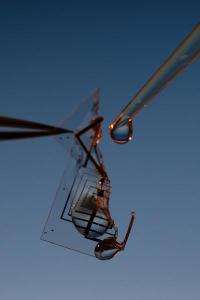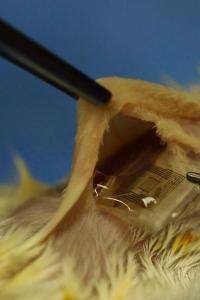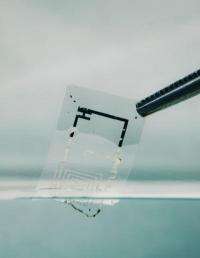'Transient electronics': Biocompatible electronic devices dissolve in body, environment (w/ Video)

Tiny, fully biocompatible electronic devices that are able to dissolve harmlessly into their surroundings after functioning for a precise amount of time have been created by a research team led by biomedical engineers at Tufts University in collaboration with researchers at the University of Illinois at Urbana-Champaign.
Dubbed "transient electronics," the new class of silk-silicon devices promises a generation of medical implants that never need surgical removal, as well as environmental monitors and consumer electronics that can become compost rather than trash.
"These devices are the polar opposite of conventional electronics whose integrated circuits are designed for long-term physical and electronic stability," says Fiorenzo Omenetto, professor of biomedical engineering at Tufts School of Engineering and a senior and corresponding author on the paper "A Physically Transient Form of Silicon Electronics" published in the September 28, 2012, issue of Science.
"Transient electronics offer robust performance comparable to current devices but they will fully resorb into their environment at a prescribed time—ranging from minutes to years, depending on the application," Omenetto explains. "Imagine the environmental benefits if cell phones, for example, could just dissolve instead of languishing in landfills for years."

The futuristic devices incorporate the stuff of conventional integrated circuits—silicon and magnesium—but in an ultrathin form that is then encapsulated in silk protein.
"While silicon may appear to be impermeable, eventually it dissolves in water," says Omenetto. The challenge, he notes, is to make the electrical components dissolve in minutes rather than eons.
Researchers led by UIUC's John Rogers—the other senior and corresponding author—are pioneers in the engineering of ultrathin flexible electronic components. Only a few tens of nanometers thick, these tiny circuits, from transistors to interconnects, readily dissolve in a small amount of water, or body fluid, and are harmlessly resorbed. Controlling materials at these scales makes it possible to fine-tune how long it takes the devices to dissolve.

Device dissolution is further controlled by sheets of silk protein in which the electronics are supported and encapsulated. Extracted from silkworm cocoons, silk protein is one of the strongest, most robust materials known. It's also fully biodegradable and biofriendly and is already used for some medical applications. Omenetto and his Tufts colleagues have discovered how to adjust the properties of silk so that it degrades at a wide range of intervals.
The researchers successfully demonstrated the new platform by testing a thermal device designed to monitor and prevent post-surgical infection (demonstrated in a rat model) and also created a 64 pixel digital camera.
Collaborating with Omenetto from Tufts' Department of Biomedical Engineering were Hu Tao, research assistant professor and co-first author on the paper; Mark A. Brenckle, doctoral student; Bruce Panilaitis, program administrator; Miaomiao Yang, doctoral student; and David L. Kaplan, Stern Family Professor of Engineering and department chair. In addition to Tufts and UIUC, co-authors on the paper also came from Seoul National University, Northwestern University, Dalian University of Technology (China), Nano Terra (Boston), and the University of Arizona.
In the future, the researchers envision more complex devices that could be adjustable in real time or responsive to changes in their environment, such as chemistry, light or pressure.
More information:
Want to know more?
Transient electronics is a new class of technology whose key feature is that they can be designed to disappear completely, without a trace, in a controlled and programmable manner. Transient devices have promising applications as bioresorbable medical implants, degradable environmental monitors, compostable consumer devices and others.
The transient electronic devices demonstrated by researchers at the University of Illinois, Tufts University and Northwestern University use magnesium electrodes and interconnects, magnesium oxide gate and interlayer dielectrics, with very thin sheets of silicon, called nanomembranes, as the semiconductor. Silicon dissolves in biofluids, but at rates that are so slow that conventional silicon wafers would take hundreds of years to degrade. By contrast, nanomembranes are thin enough to dissolve in a few days or weeks, depending on their thickness, in only a few droplets of water. Yet they are thick enough to enable high-quality semiconductor devices, such as transistors, diodes and others.
Both silicon and magnesium occur naturally in the environment and have been explored for various medical implants and drug-delivery systems, although in bulk structural forms. The amount of each material in a transient electronic system is much smaller than the recommended daily allowance – the magnesium is even less than that found in a multivitamin – or even less than normal physiological levels. At the same time, it is enough for sophisticated electronics with integrated functions.
"These classes of materials have been explored for use in intravascular stents, porous bodies for drug delivery, sutures and other non-electronic medical applications," said John A. Rogers, a mechanical science and engineering professor at U. of I. who led the research. "We've figured out how to put those same materials together in ways that yield high-quality electronics, sensors and power delivery systems."
The devices are encapsulated in layers of silk, collected from silkworm cocoons, dissolved and recrystallized. By carefully controlling the crystal structure of the silk, the researchers can control the dissolution rate, so that they can tune the lifespan of a transient device for a specific application. The timescales for dissolution can range from a few minutes to days, weeks, months or potentially, years, all depending on the silk packaging.
Journal information: Science
Provided by Tufts University

















